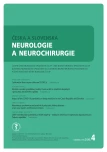Glatirameracetate – the treatment of multiple sclerosis monitored in the ReMuS Registry
Authors:
R. Taláb 1; M. Talábová 2
Authors‘ workplace:
Neurologická klinika LF UK a FN Plzeň
1; Neurologická klinika LF UK a FN Hradec Králové
2
Published in:
Cesk Slov Neurol N 2020; 83/116(4): 401-407
Category:
Original Paper
doi:
https://doi.org/10.14735/amcsnn2020401
Overview
The data of patients with MS treated in the Czech Republic with glatirameracetate (GA) entered in both etrospectively and prospectively the Registry of Multiple Sclerosis (ReMuS) registry are presented. Outputs from the registry were processed over the period from its foundation on January 1, 2013 to June 30, 2018 focusing on patients treated daily with subcutaneous 20 mg/ml of GA (GA20) or subcutaneous 40 mg/ml (GA40) 3 times per week. Data of a total of 3,527 patients who were treated with GA20 or GA40 during the period monitored were analysed. 868 patients (24.6%) were treated during the entire monitored period and treatment in this period was started in 1,929 patients (54.6%). At the end of the reference period, a total of 2,190 (62.1%) patients were treated with GA. In this subgroup, 205 patients (9.4%) were treated with GA 20 and 1,985 patients (90.6%) with GA 40. Treatment with GA was finished in 634 (32.9%) patients, out of whom 521 (82.2%) were included for treatment escalation and 113 patients (17.8%) discontinued immunomodulatory therapy.
Keywords:
Multiple sclerosis – clinically isolated syndrome – glatirameracetate
Sources
1. Lebrun-Frenay C, Moulingnier A, Pierrot-Deseilligny C et al. Five-year outcome in the copaxone observatory: a nationwide cohort of patients with multiple sclerosis starting treatment with glatiramer acetate in France. J Neurol 2019; 266 (4): 888–901. doi: 10.1007/s00415-019-09211-5.
2. Štourač P, Praksová P, Kontrová I et al. Glatiramer acetát (Copaxone) v léčbě atakovité forma roztroušené sklerózy mozkomíšní – klinická účinnost a bezpečnostní profil. Cesk Slov Neurol N 2011; 74/107 (4): 447–454.
3. Weber MS, Hohlfeld R, Zamvil SS. Mechanism of action of glatiramer acetate in treatment of multiple sclerosis. Neurotherapeutics 2007; 4 (4): 647–653. doi: 10.1016/j.nurt.2007.08.002.
4. Krejsek J. Glatiramer acetát – protizánětlivé a neuroprotektivní mechanismy účinku. REMEDIA 2014; 6: 464–467.
5. Arnon R, Aharoni R. Neurogenesis and neuroprotection in the CNS – funfamental elements in the effect of glatiramer acetate on treatment of autoimmune neurological disorders. Mol Neurobiol 2007; 36 (3): 245–253. doi: 10.1007/s12035-007-8002-z.
6. Johnson KP, Brooks BR, Ford CC et al. Sustained clilnical benefits of glatiramer acetate in relapsing multiple sclerosis patients observed for 6 years. Multiple Sclerosis 2000; 6 (4): 255–266. doi: 10.1177/135245850000600407.
7. Comi G, Martinelli V, Rodegher M et al. Effect of early treatment with glatiramer acetate in patients with clinically isolated syndrome. Mult Scler 2013; 19 (8): 1074–1083. doi: 10.1177/1352458512469695.
8. Taláb R. Glatiramer acetát v České republice – výstupy z registru ReMuS. REMEDIA 2017; 27: 46–52.
9. Ziemssen T, Ashtamker N, Rubinchick S et al. Long--term safety and tolerability of glatiramer acetate 20mg/ml in the tratment of relapsing forms of multiple sclerosis. Expert Opin Drug Saf 2017; 16 (2): 247–255. doi: 10.1080/14740338.2017.1274728.
10. Davis MD, Ashtamker N, Steinerman JR et al. Time course of glatiramer acetate efficacy in patients with relapsing-remitting multiple sclerosis (RRMS) in the Glatiramer Acetate Low-frequency Administration (GALA) study. Neurol Neuroimmunol Neuroinflamm 2017; 4 (2): e327. doi: 10.1212/NXI.0000000000000327.
Labels
Paediatric neurology Neurosurgery NeurologyArticle was published in
Czech and Slovak Neurology and Neurosurgery

2020 Issue 4
Most read in this issue
- It is evident when to make a surgery for lumbar disc herniation?
- CGRP monoclonal antibodies in the treatment of migraine – indication criteria and therapeutic recommendations for the Czech Republic
- Current diagnostics of secondary progressive form of multiple sclerosis and its treatment with siponimod
- Cytotoxic lesions of the corpus callosum (CLOCCs)
